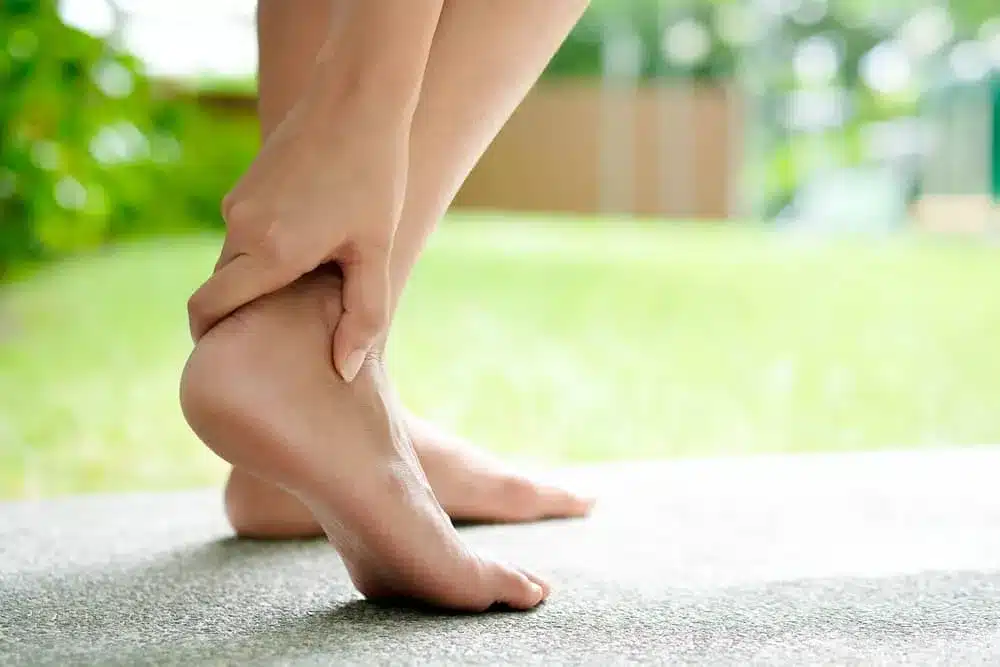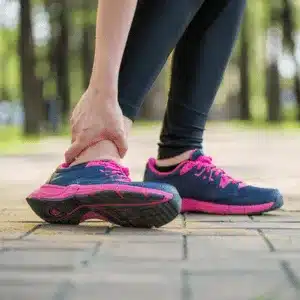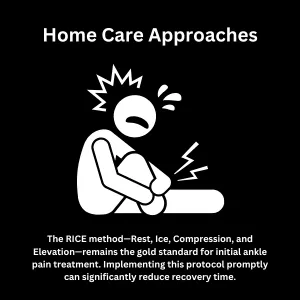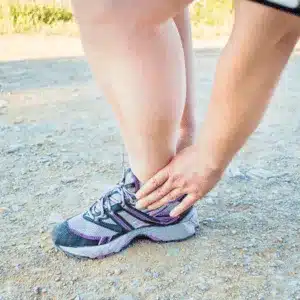
Walking with ankle pain causes everyday movements to become difficult situations for your daily life. Daily activities remain accessible through the use of effective ankle pain treatment, whether you're dealing with a sprained ankle, flat feet, or general discomfort. Dallas, Texas residents together with Sunnyvale citizens must identify the sources causing their pain to establish effective treatment paths.
Ankle pain occurs in millions yearly, and people often stay away from proper medical treatment—which causes both additional damage to the ankle and longer recovery periods. Situation-related ankle pain during walking indicates your body needs examination; incorporating physical therapy into your treatment plan can accelerate recovery and restore mobility.

The ankle functions as a complex structure to support full body weight and accommodates a diverse motion range. Due to its intricate design, the foot or ankle presents multiple points where vulnerability leads to numerous injuries resulting in ankle pain, including issues related to plantar fasciitis or even the big toe.
Three key structures form the ankle joint between the shinbone (tibia), the smaller leg bone (fibula), and the heel bone (talus). The three bones, including the talus and calcaneus (heel bone), support the ankle structure as its essential framework.
These bones receive support from several ligaments and many tendons, with the prominent Achilles tendon among them, and additional connective tissues. The complex structure of ankle bones plus various supporting elements demonstrates that correct diagnosis by Sunnyvale orthopedic specialists becomes vital—often followed by physical therapy—because ankle pain stems from so many possible root causes.
A sprained ankle occurs when ligaments are stretched or torn, often from a sudden twist or roll of the ankle. This is one of the most common ankle pain foot injuries in Dallas and Sunnyvale residents, especially among those who enjoy outdoor activities.
Fractures range from hairline cracks to complete breaks in any of the ankle bones. Even small fractures can cause severe ankle pain and make walking extremely difficult without proper treatment.
The Achilles tendon, which connects your calf muscles to your heel, can develop tendinitis (inflammation) or tendinopathy (degeneration) from overuse. Achilles tendinosis, a chronic condition, occurs when the tendon develops small tears that don't heal properly.
Scar tissue formation after previous ankle injuries can create ongoing discomfort, especially when walking on uneven surfaces common throughout Texas parks and trails.
Plantar fasciitis develops when the plantar fascia becomes inflamed. This condition often causes intense pain with the first few steps after resting.
Posterior tibial tendon dysfunction occurs when the tendon supporting your arch becomes inflamed or torn. Left untreated, this can lead to adult acquired flatfoot deformity, a progressive condition affecting your ability to walk normally.
Stress fractures are tiny cracks in bones caused by repetitive force rather than a single injury. These overuse injuries commonly affect active individuals who suddenly increase their walking or running mileage around Sunnyvale's beautiful outdoor spaces.
Bursitis involves inflammation of the small fluid-filled sacs (bursae) that cushion your ankle joints. This condition often results from prolonged standing or repetitive movements common in many workplace environments.

Osteoarthritis gradually wears away joint cartilage, causing ankle pain in the affected joint. This condition typically affects seniors but can develop earlier in those with previous ankle injuries, or soft tissue damage in the foot or ankle.
Rheumatoid arthritis is where your immune system attacks your joints, causing pain throughout the foot and ankle. This condition requires specialized treatment approaches like physical therapy to preserve joint function and reduce chronic pain.
Gout occurs when uric acid crystals accumulate in joints, often affecting the big toe joint first. The burning pain from gout attacks can make walking nearly impossible, especially when the ankle hurts during movement or if other foot problems exist.
Flat feet (fallen arches) can alter your walking mechanics, placing excess strain on ankle structures. Many Sunnyvale residents notice foot pain develops gradually as they age, particularly after long periods of activity or recovering from a soft tissue injury or a broken ankle, though arch supports may help reduce strain.
Reactive arthritis can develop after certain infections, causing joint inflammation and pain throughout the body, including the ankles. This condition requires prompt medical attention from specialists familiar with its unique presentation, often supported by physical therapy for long-term relief of pain..
Swelling around the ankle is often the first visible sign of a problem. This excess fluid accumulation indicates inflammation and can range from mild to severe, sometimes making it difficult to see your ankle bones.
Bruising typically indicates damaged blood vessels from injury. The pattern and extent of bruising can help orthopedic specialists in Dallas determine what structures might be affected.
If you feel foot pain that radiates up to your lower leg, this may indicate more complex issues involving nerves or referred pain patterns that require comprehensive evaluation.
Instability or the sensation that your ankle might "give way" when walking suggests ligament damage. This symptom should never be ignored as it increases your risk for falls and additional injuries.
Popping or clicking sounds when moving your ankle may indicate loose fragments within the joint or tendons snapping over bones. These mechanical symptoms often require specialized imaging for proper diagnosis.
Stiffness, especially first thing in the morning or after sitting for long periods, can indicate arthritis or inflammatory conditions affecting the ankle joint. Morning stiffness that lasts more than an hour might suggest rheumatoid arthritis.
Burning pain could indicate nerve compression or neuroma. Morton's neuroma, while more common in the foot, can sometimes cause symptoms that extend toward the ankle.
When you visit Sunnyvale Orthopedics with ankle pain, our specialists begin with a thorough physical examination. This includes assessing your range of motion, stability, and pinpointing exactly where you feel pain.
X-rays provide clear images of bone structures and can identify fractures, arthritis, or bone spurs. These quick, painless tests are often the first imaging studies performed at our Sunnyvale facility.
For more detailed evaluation of soft tissue injuries like ligament tears or achilles tendinitis, MRI (Magnetic Resonance Imaging) may be recommended. This advanced imaging helps visualize tissues that don't appear on X-rays.
In some cases, ultrasound imaging helps diagnose tendon problems. This dynamic imaging technique allows specialists to observe structures while they're in motion.

The RICE method—Rest, Ice, Compression, and Elevation—remains the gold standard for ankle pain treatment. For Sunnyvale residents, implementing this protocol promptly can significantly reduce recovery time.
Rest doesn't necessarily mean complete immobilization. Instead, avoid activities that worsen symptoms.
Apply ice to the painful area for 15-20 minutes several times daily to reduce swelling and relieve pain. Always wrap ice packs in a thin towel to protect your skin.
Compression with an elastic bandage helps control swelling and provides support. Ensure it's snug but not tight enough to impair circulation to your foot.
Elevating your foot above heart level helps drain excess fluid and reduce swelling. This simple technique is particularly effective when combined with the other RICE components.
Over-the-counter anti-inflammatory medication can help manage pain. However, these should be used according to package directions.
Physical therapy plays a crucial role in ankle rehabilitation. A skilled physical therapist can design a program to restore strength, flexibility, and proper movement patterns tailored to your specific condition, whether symptoms appeared a few days or a few weeks ago.
Manual therapy techniques, including therapeutic massage and joint mobilization, help restore normal movement and break down scar tissue that may be restricting motion or causing pain near the little toe or the achilles tendon.
Bracing provides external support while injured tissues heal. From simple ankle braces available at local pharmacies to custom-fitted devices and soft sole options, the right support can make walking significantly more comfortable.
Heel lifts or other specialized orthotic modifications, including soft insoles or shoe inserts, can offload pain from specific structures, allowing inflammation to subside and tissues to heal properly.
Corticosteroid injections may be recommended for severe inflammation that doesn't respond to other treatments. These powerful anti-inflammatory medications can provide significant relief when delivered directly to the affected joint, especially in cases like achilles tendinopathy.
For persistent cases, regenerative medicine treatments use components from your own blood to promote healing. These cutting-edge therapies are available right here in Sunnyvale and are helpful when the ankle hurts due to achilles tendinitis or reactive arthritis.
From arthroscopic procedures to repair damaged ligaments to joint replacement for severe arthritis or chronic achilles tendinopathy, Sunnyvale Orthopedics offers comprehensive surgical solutions for a range of acute injuries.
Our integrated approach ensures seamless coordination between surgical and rehabilitation specialists throughout your recovery journey, especially if you're experiencing difficulty walking after surgery or due to chronic ankle issues.

Strengthening exercises for the muscles supporting your ankle joint help prevent injuries. Simple exercises like calf raises and resistance band routines can be performed at home to build stability.
Balance training reduces your risk of ankle sprains by improving proprioception—your body's ability to sense its position in space. Try standing on one foot while brushing your teeth to incorporate balance work into your daily routine.
Proper footwear selection is crucial for preventing ankle problems. Supportive shoes should provide adequate support, fit properly, and be appropriate for your specific activities.
Warming up before exercise prepares your muscles and tendons for activity. A proper warm-up increases blood flow to tissues, making them more resilient to pain.
Maintaining a healthy weight reduces pain on your ankles. Each extra pound places additional force on these joints during walking and other activities.
Gradually increasing activity levels allows your body to adapt to new stresses. This is especially important when beginning new exercise programs or returning to activities after periods of inactivity.
If you notice pain that persists beyond a few days despite home treatment, it's time to consult with ankle specialists at Sunnyvale Orthopedics. Early intervention often leads to simpler treatment and faster recovery, especially when guided by a skilled physical therapist.
Inability to bear weight on your foot or ankle may indicate a serious injury. Don't attempt to "walk it off" if the pain is severe or accompanied by other symptoms.
Significant swelling and heel pain that doesn't improve with RICE could signal a more complex issue. Risk factors like previous injuries or improper foot mechanics while wearing shoes may contribute.
Visible deformity of the ankle should prompt immediate medical attention. In some cases, damaged soft tissue or tendons that connect muscles to bones may also be involved.
Life in Sunnyvale and Dallas should be enjoyed without the limitations of foot and ankle pain, especially when effective care is available.
Recurrent ankle injuries suggest underlying instability or biomechanical pain. A physical therapist can help identify the causes and create a plan that supports recovery and pain prevention.
Ankle pain when walking doesn't have to limit your lifestyle in Sunnyvale or the greater Dallas area. Understanding the potential causes and recognizing when to seek professional help are crucial first steps toward recovery.
At Sunnyvale Orthopedics, our team specializes in diagnosing and treating the full spectrum of foot and ankle conditions affecting Texas residents. From conservative approaches to advanced surgical techniques, we offer comprehensive care tailored to your specific needs.
Don't let foot and ankle pain keep you from enjoying all that Sunnyvale has to offer. Our experienced orthopedic specialists can provide expert care to get you moving comfortably again.
Remember, addressing foot and ankle pain promptly not only provides pain relief but also helps prevent long-term complications that could affect your mobility and quality of life.